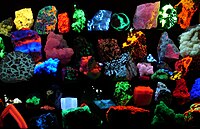
Photo from wikipedia
Phycobiliproteins are constituents of phycobilisomes that can harvest orange, red, and far‐red light for photosynthesis in cyanobacteria and red algae. Phycobiliproteins in the phycobilisome cores, such as allophycocyanins, absorb far‐red… Click to show full abstract
Phycobiliproteins are constituents of phycobilisomes that can harvest orange, red, and far‐red light for photosynthesis in cyanobacteria and red algae. Phycobiliproteins in the phycobilisome cores, such as allophycocyanins, absorb far‐red light to funnel energy to the reaction centers. Therefore, allophycocyanin subunits have been engineered as far‐red fluorescent proteins, such as BDFP1.6. However, most current fluorescent probes have small Stokes shifts, which limit their applications in multicolor bioimaging. mCherry is an excellent fluorescent protein that has maximal emittance in the red spectral range and a high fluorescence quantum yield, and thus, can be used as a donor for energy transfer to a far‐red acceptor, such as BDFP1.6, by FRET. In this study, mCherry was fused with BDFP1.6, which resulted in a highly bright far‐red fluorescent protein, BDFP2.0, with a large Stokes shift (≈79 nm). The excitation energy was absorbed maximally at 587 nm by mCherry and transferred to BDFP1.6 efficiently; thus emitting strong far‐red fluorescence maximally at 666 nm. The effective brightness of BDFP2.0 in mammalian cells was 4.2‐fold higher than that of iRFP670, which has been reported as the brightest far‐red fluorescent protein. The large Stokes shift of BDFP2.0 facilitates multicolor bioimaging. Therefore, BDFP2.0 not only biolabels mammalian cells, including human cells, but also biolabels various intracellular components in dual‐color imaging.
Journal Title: ChemBioChem
Year Published: 2019
Link to full text (if available)
Share on Social Media: Sign Up to like & get
recommendations!